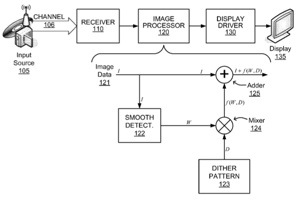An Apple patent (number 20110135011) for adaptive dithering during image processing has appeared at the US Patent & Trademark Office. Systems and method are provided for adjusting certain pixel values in an image.
In an embodiment of the invention, an average pixel value of pixels at given distances from a selected pixel are examined to determine if the pixel is in a high-contrast area. If the pixel is in a smooth color gradient transition area, the pixel value may be adjusted in some embodiments using an additional dither or dither pattern to reduce differences between the pixel values of the selected pixel and the additional average pixel values exceeding the lower threshold. The inventors are Alex Eddy and Nick Burns.
Here’s Apple’s background and summary of the invention: “When image data, such as data representing a photograph, picture, or video, is processed electronically by a computing device, the device may not be able to display the original image with complete fidelity. In some instances, artifacts not found in the original image may appear in the electronically-processed image. For example, in some electronically processed images, discrete color bands with various intensities and color levels may appear in lieu of smooth color transition gradients contained in the original image. These banding artifacts may become even more noticeable in resource or bandwidth limited devices. Image processing resources may be determined by various factors including the color space implementation, compression algorithms, and color correction implementation.
” Many electronic and computing devices use technologies based on a fixed bit color space implementation which limits the possible number of different colors used. For example, video cards and processors in many digital devices such as computer and video game consoles may be configured to process images in 8 bit, 16 bit, and/or 24 bit RGB color models. In a 16 bit RGB color model there are generally 2.sup.16 or 65,536 different possible colors, typically with 2.sup.5 or 32 different shades of red and blue, and 2.sup.6 or 64 different shades of green assignable to each pixel. In a 24 bit color model there may be up to 2.sup.24 or 16,777,216 different possible colors with 2.sup.8 or 256 different shades of red, green, and blue assignable to each pixel. While having over 16.7 million different possible colors may seem large, the human eye is still able to detect changes from one color to the next.
“Many electronic and computing devices also use various lossy image compression techniques to maximize use of image processing resources. Often, these lossy image compression techniques further exacerbate banding artifacts in electronically processed images. Lossy image compression techniques, such as JPEG, MPEG, and H.264, exacerbate banding artifacts by reducing the number of colors in an image to save space. For example, some compression methods examine small pixel blocks in an image and average out different colors in each block using a transform function, such as a discrete cosine transform to even out the color and reduce the total number of colors. By further reducing the number of available colors, the differences between different color shades and transition bands become even more pronounced.
“While it may be desirable to reduce banding artifacts in smooth color transition areas of an image, it may also be desirable to maintain definite color transition bands in certain high contrast areas of an image. For example, sections of an image involving contrasting colors, such as those found in an image of an intricate Oriental carpet may contain definite transition bands between the contrasting regions to maintain sharpness and detail. Removing these definite transition bands may result in a loss of detail and a perception of a lower image quality.
“Thus, there is a need to reduce banding artifacts in smooth color gradient transition areas of an image while maintaining definite transitions between colors in areas with greater contrast.”
— Dennis Sellers



